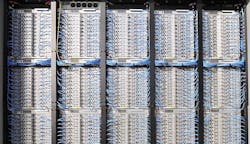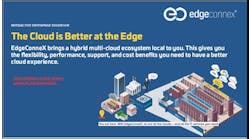Microsoft today announced plans to expand its global cloud computing operations with new data centers in Sweden, projecting that the new facilities will be the company’s most advanced and sustainable to date by integrating renewable energy sources, and a new data center design.
Microsoft also said the new data centers will be designed as “zero waste” operations, and hinted at future plans to use its blockchain services to manage its data center assets.
As part of ongoing research, Microsoft “plans to launch a new data-driven circular cloud initiative using the Internet of Things (IoT), blockchain and artificial intelligence (AI) to monitor performance and streamline the reuse, resale and recycling of data center assets, including servers,” the company said.
“We intend for our data centers in Sweden to be among the most sustainably designed and operated in the world with the ultimate ambition of achieving zero-carbon operations,” said Noelle Walsh, CVP, Cloud Operations & Innovation for Microsoft, in a blog post announcing the expansion. “The data center design we’re developing will further Microsoft’s ongoing commitment to transition to a sustainable, low-carbon future.”
The company did not provide specifics on the design components that would allow it to reach zero-carbon impact. But it’s a claim to be taken seriously, as Microsoft has a long history of innovation to improve the sustainability of its data centers, including operating at extreme efficiency.
Green Energy as a Development Magnet
The announcement continued the momentum for Sweden as a data center destination. The country is home to a major data center campus for Facebook in Lulea, as well as a newly-opened Amazon Web Services cloud region around Stockholm. Earlier this week Google said it would invest an additional $670 million to build more data centers on its cloud campus in Hamina, Finland. Norway is also actively marketing itself as a growth market for hyperscale data centers.
The cloud growth in the Nordics is reflects the two major strategies the hyperscale computing operators are following in expanding their data center footprint in Europe. These companies are adding capacity in the Nordic countries, taking advantage of the region’s renewable energy resources and cool climate to build web-scale cloud campuses. The hyperscalers are also adding capacity in Europe’s major business markets, including the FLAP cities (Frankfurt, London, Amsterdam and Paris) as well as Dublin.
The Microsoft announcement was welcomed by Node Pole, the economic development agency promoting Sweden to the data center industry.
“It is great news for Sweden, which continues to attract data center investments with its unique conditions,” said Patrik Öhlund, CEO of Node Pole. “Here they can make full use of Sweden’s advantages such as a low carbon footprint in the energy mix, a world-class electrical grid and very competitive costs. Also, Sweden has a proven track record of delivering industrial projects on time and budget.”
Microsoft will collaborate with local utility Vattenfall to source renewable energy for the data centers.
“Vattenfall will develop new energy infrastructure to support this data center development in Sweden to ensure ample and reliable power for the facilities and improved reliability to the region,” said Andreas Regnell, Senior Vice President, Strategic Development, Vattenfall. “We will support Microsoft on the sourcing and supply of renewable energy for the future data centers and help provide innovative solutions to reduce the carbon footprint of the data centers.
“Over time, the new infrastructure will help further reduce the carbon footprint of the data centers, while at the same time reinforce an already strong electricity grid in Gävle and Sandviken to the benefit of the people who live there,” Regnell added. “Vattenfall is fully committed to help our customers make fossil free living possible within one generation, so this partnership fits very well with our overall strategy.”
Innovating Around Sustainability, Efficiency
Microsoft continues to innovate in its data center operations, seeking improved efficiencies and new ways to operate sustainably. The company is competing aggressively in the cloud computing market, where its chief rivals include Amazon Web Services, Google and Oracle.
The company indicated that the new Swedish campus would include new designs focused on sustainability, but shared no additional details.
Microsoft’s Generation 5 design, introduced in 2016, features a cement slab rather than a raised floor, and servers are housed in rows of racks that are connected to a hot-aisle containment system. A fan wall on one side of the facility manages airflow into the data hall, which functions as a room-level cold aisle – although “cold” is a relative term, as Microsoft can operate its data centers with server inlet temperatures above 80 degrees.
The company’s novel underwater data center design, known as Project Natick, could also play a key role in Microsoft’s future infrastructure. CEO Satya Nadella has said that underwater infrastructure can bring Microsoft’s Azure cloud and edge technology to large numbers of future users.
“Since 50 percent of the world’s population lives close to bodies of water, we think this is the way we want to think about the future of data center regions and expansion,” said Nadella.
These initiatives are all part of Microsoft’s vision for a future in which technology infuses almost every area of modern life, a trend the CEO called “tech intensity.”






